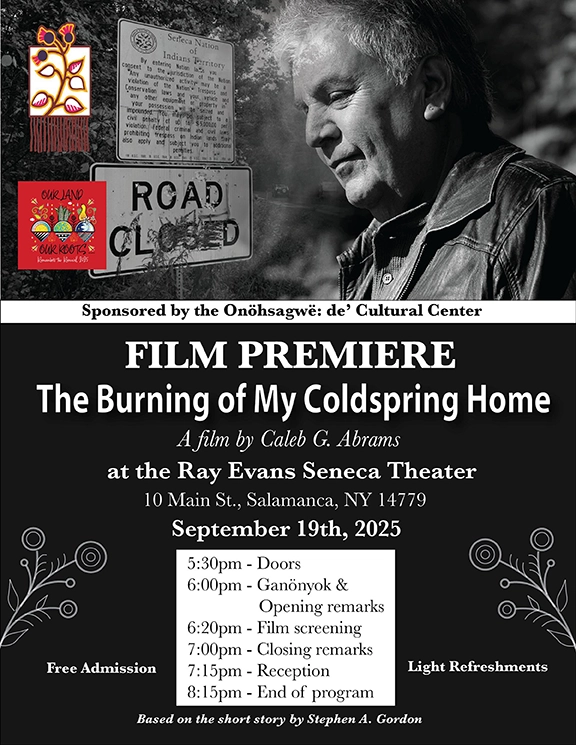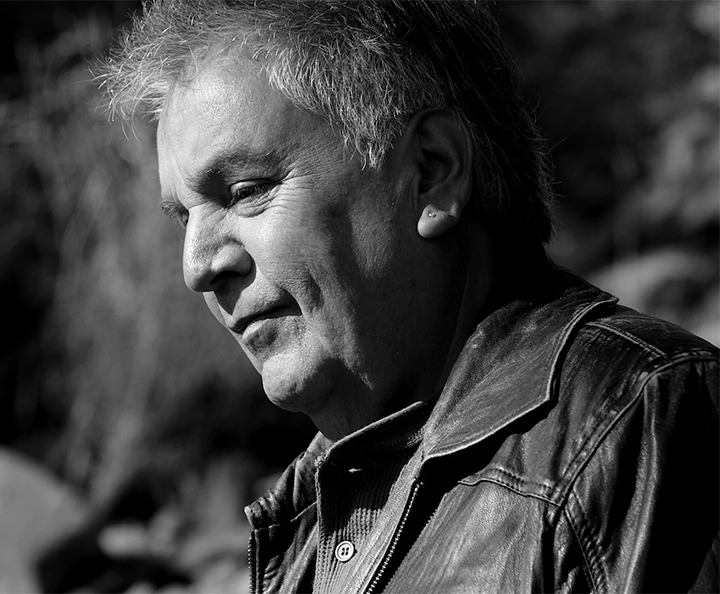at Ray Evan’s Theater
By Norah Stevens, Reporter
With the upcoming premiere of “The Burning of My Coldspring Home” – a film Directed and Produced by Caleb G. Abrams at the Ray Evans Seneca Theater (10 Main St., Salamanca, NY 14779) on September 19, 2025, SNI Newsletter reached out for an interview.
Caleb G. Abrams, a local Ohi:yo’ hometown native, has shared some insight into his film about the late Stephen “Steve” Gordon. Producing this film was not an easy journey, his evolution as a filmmaker reflecting in this cinematic endeavor. He knew that he had an important message he wanted to convey and set a standard that he wanted to achieve.

The origin of the film started back in 2011 when Caleb was working for the Kinzua Dam Relicensing Commission. KDRC was established in 2010 to pursue an expiring electricity license, to get it relicensed to own and operate the Kinzua Dam. Caleb’s job at KDRC was to interview Seneca elders who had lived through the relocation caused by the dam. His supervisor at the time, Wendy Huff, had offered up a story written by Stephen Gordon that he had only shared amongst friends, colleagues and the KDRC.
Unfortunately, the relicensing did not go in the Seneca Nation’s favor. However, the experience led Caleb to Steve Gordon’s story – a first-hand account of the tragedy 60 years ago. Upon initially reading Steve’s story, Abrams was blown away because it had such a raw, honest and intimate account of how the relocation felt. Stephen’s writing had an enormous impact on Caleb. It was different from hearing elders quietly share their experiences or the acknowledgements at the Remember the Removal events. It was the polished work of someone who was really digging into the emotions and made the reader feel empathetic to his trauma
The Burning of My Coldspring Home honors Steve’s life story, an honest and unique experience. The film has been in production for 14 years, nearly half of Caleb’s life. Over the years, other film projects took priority, but this one was always very special. Caleb wanted to do it justice and had patience. After Stephen’s passing Caleb said he felt a greater responsibility to tell his story. Steve would be proud to reclaim that history and truth.
Starting out small, Caleb laughed, recalling that the first original take was shot on an iPhone in 2011. From there, a second take was done on a better recorder, the third attempt was an even better one. Eventually leading to 2019 when he brought Steve to a studio in Buffalo, New York with a professional studio setting and all the necessary equipment. He appreciated Steve’s patience and understanding that as a director and producer Caleb had a vision of how he wanted to portray his experience and give his story justice.
During the development of the film, Caleb often thought about how he wanted to make something that survivors could watch and say, “That is what it felt like!” or “That is what it looked like!” and connect with it. Caleb’s grandchildren and future generations will not get the chance to know someone who lived through the relocation. This film is an attempt to bridge the gap for future generations who will never get to speak with survivors of the removal. It took balance to create a visual piece based on trauma and education. It is a tragedy portraying the destruction of our communities, which is heavy but educating cannot shy away from the difficult parts.
Caleb also expressed that he wanted to be very clear with the viewers of this film, especially Seneca viewers – Kinzua era relocation survivors in particular – this film is going to be a tough watch. It is very emotional. As an artist and a filmmaker, he stands by his decision to include the brutality of the story – one day you are living in a house and the next day you come home from school to invaders setting fire to your house, along with the longhouse, churches, and cemeteries. As a child, radical change and overwhelming experiences can leave trauma that carries to the next generation. Being displaced in a new home miles away and everything is different was a jarring life-changing experience for many Seneca survivors. Unfamiliar experiences with electricity, indoor plumbing, and doors with various rooms caused distress. The brutal reality of our loss and severe toll it took on the Allegany River and its survivors is the message he hopes to carry forward to the future generations of Senecas. His hope is to give non-Senecas education and clarity on the historical and generational trauma that carries on.
Caleb’s vision was to infuse both humanity and beauty into the production. Knowing the tender moments are heavy, grief counselors will be available at the premiere to talk with along with other resources available for people to schedule appointments in the following week.
It was a tough decision to include sensitive topics in the film. It is not Caleb’s intent to upset the crowd, but he feels brutal honesty is critical to the film. Steve’s narrative may become one of the few definitive accounts of what the removal experience was like for those that will never hear it firsthand.
Caleb shares that it was a gift to be able to learn, work and spend time with elders through this experience. It’s important to tell our own stories from our own perspective. As a filmmaker and documentarian, Caleb takes that role seriously and will continue to tell our stories authentically and respectfully.
Back when this all started, he was just “Rovena’s grandson” along with Caleb’s attempts to Steve to ask “Hey, you know that story you don’t share with anybody? Can I make that into a movie?” To which Steve had agreed and from there a real friendship and mentorship was formed. Looking back, Caleb viewed Steve as a grandpa, an uncle and formed a bond that developed into a production. It has been a privilege for Caleb and his team to produce this film, and it would not have been possible without the help of so many locals and beyond.
The credits in this film are quite long but he wanted to thank and give credit to everyone who helped whether it was finding pictures, staying late, doing interviews. He also wanted to give a special thanks to the Seneca-Iroquois National Museum, the Remember the Removal Committees over the years, and so many others.
“I am thrilled to announce that my new film, The Burning of My Coldspring Home (#mycoldspringhome) will be premiering at the Ray Evans Seneca Theater in Ohi:yo’ on Friday, September 19! Program details forthcoming.
I’m so proud of this work. It’s an intimate, patient, and I think, beautiful ode to Joneganoh, the ancestors, the elders, our families, our future, and of course, my dear friend, teacher, and collaborator, Steve Gordon geo. I cannot wait to finally share this film with the world, beginning with Ohi:yo’
What a privilege it has been. Stay tuned for posts announcing future screenings and opportunities to view the film in the coming weeks and months, shared Caleb Abrams.”
FILM PREMIERE:
The Burning of My Coldspring Home a film by Caleb G. Abrams at the Ray Evans Seneca Theater 10 Main St., Salamanca, NY 14779 on September 19, 2025 :
5:30pm – Doors Open
6:00pm – Ganönyok & Opening Remarks
6:20pm – Film Screening
7:00pm – Closing remarks
7:15pm – Reception
8:15pm – End of program
Based on the short story by Stephen A. Gordon
- Free Admission
- Sponsored by the Onöhsagwe:de’ Cultural Center
- Light Refreshments will be provided




